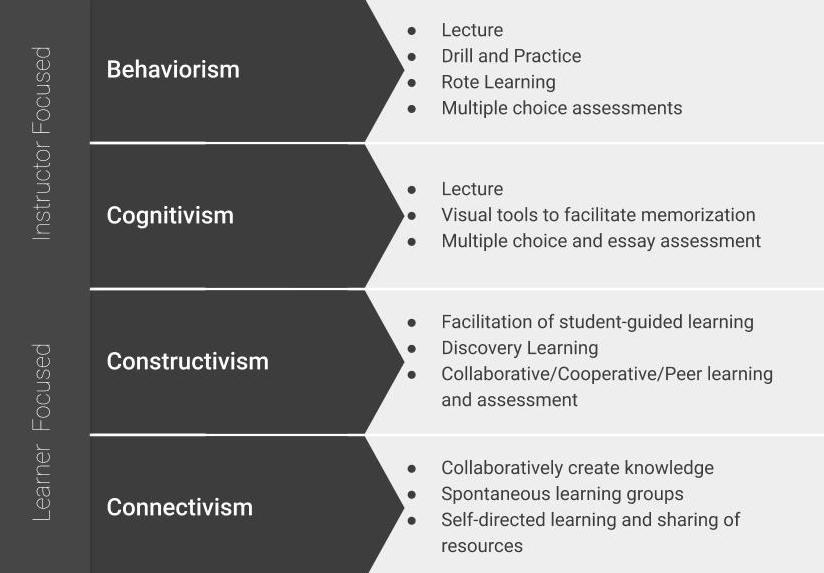Learning Theories Concept Map

Access Artefact Here
Course: INSDSG 602 - The Adult as Learner
Assignment Description: This assignment focused on conceptualizing the four fundamental learning theories (behaviorism, cognitivism, constructivism, connectivism), the theorists involved, and the key ideas for the theories. A concept map, conceptual framework, or infographic could be used to describe their interpretation of the foundational learning theories and how the key ideas relate to instructional design. It was required to include key theorists, the key ideas behind each theory, 2-3 paragraphs that explain the conceptualization, cite the sources, and include references cited list.
Competencies
| Theory into Practice | 1.1 Complete scholarly research including searching, locating, and analyzing literature in the field. 1.2 Interpret practical learning principles and their applications from various landmark learning theories. 1.3 Apply interdisciplinary research findings to the solution of performance problems. 1.4 Critically assess reliable publications, literature, trends, theories, data, and tools used in the field of instructional design. |
| Analysis | 2.1 Seek multiple data and information points when conducting analysis. 2.5 Use analysis to recommend instructional and non-instructional solutions.2.6 Report analysis and proposed solutions in a clear, concise manner so that others can understand and evaluate proposed solutions. |
| Design | 3.1 Develop performance outcomes that are measurable, have a specific action, and have specific conditions stated. 3.2 Use evidence-based instructional strategies to maximize learning. 3.3 Design appropriate multimodal instructional delivery, including face-to-face, online,blended, and emerging modes. 3.5 Draw on a range of instructional design models to craft effective instructionalinterventions. 3.6 Design effective formal and informal learning solutions. |
| Development | 4.4 Apply visual literacy concepts and principles in the planning, layout, and design of learning materials. 4.6 Develop learning materials based on sound cognitive research findings. |
| Implement | 5.3 Apply effective practices that encourage learner interaction, engagement, andlearning. 5.4 Stay current with emerging trends in delivery modes and their related technologies. |
| Reflective Practice | 7.2 Act mindfully and advocate on behalf of the learner. 7.4 Communicate clearly, collegially, and credibly in written and verbal discourse. |
Introduction
Creating this artefact required exploring learning theories and relating them to the instructional design process, particularly for adults. I got into the instructional design field without a background in education. Before starting my master's degree, I attended workshops and training where I learned about developing learning objectives, assessing performance problems, identifying solutions, developing learning tools, and the characteristics of adult learners, among other topics related to instructional design. However, I had never studied learning theories. I decided to include it in my portfolio because it is essential for an instructional designer to understand and incorporate learning theories when designing instruction because of the focus and direction it provides to the process. (McLeod, 2003).
Reflection
It was in this course that I first heard about learning theories. Each theory could have its course because of the number of theorists, concepts, and applications to instructional design that can be analyzed. To complete this assignment and develop my conceptualization of the learning theories required to explore each theory. I went deeper into them by reading and analyzing articles, books, and content available on the internet (1.1, 1.4, 2.1). Designing an effective instructional process requires more than simply executing various steps within an instructional design model; it needs to consider the theoretical bases on which it is grounded (McLeod, 2003). While exploring theories, I recognized that although they do not give us solutions to performance problems, they can direct our attention to those factors crucial to finding the solution (1.2, 1.3).
To describe my interpretation of the theories, I created an infographic using PowerPoint and combined image and text elements in a simple and visually appealing format that would facilitate understanding the information about each theory. Creating the artefact required a deeper understanding of each theory to identify the possible applications of each theory in the instructional design process and finally put all that knowledge in an infographic. However, the creation of the infographic was quite simple and easy because I enjoy graphic design and having the freedom to be creative (3.6, 4.4).
An exciting aspect of the process of exploring learning theories was to see them as a lens to view a learning problem from different perspectives (2.1) since, depending on the theory used, the solution might look different (2.5)(McDonald & West, 2021). Knowing the different ways learning occurs helps us identify potential activities and tools that can lead the learner to achieve the learning objectives (3.1). Therefore, learning theories become a tool that helps us to structure learning by considering the best strategy to achieve the desired learning outcomes (3.2, 3.3, 3.5, 5.3).
With the accelerated progress of technology and the dynamic contexts in which learning can occur, it is necessary to incorporate a combination of the theories in the instructional design process to obtain optimal learning (McLeod, 2003). Additionally, it will be interesting to explore in depth how new technologies (5.4), such as virtual reality and augmented reality, could give a new twist to the applications of each theory since by altering reality, they also alter the interaction and stimuli, not only with the instructor but also with the environment and relationships.
Application
As indicated by McDonald & West (2021) “the learning theories give instructional designers a language and structure to communicate their designs and research to give evidence that their designs will be effective (2.6, 7.4). Using learning theories helps guide the design or learning solution during the instructional design process (4.6) and helps justify the design solution as an effective one for potential clients” (p. 203) (7.2, 8.1).
Image source: McDonald, J. K. & West, R. E. (2021). Design for Learning: Principles, Processes, and Praxis (1st ed.). EdTech Books. https://edtechbooks.org/id
